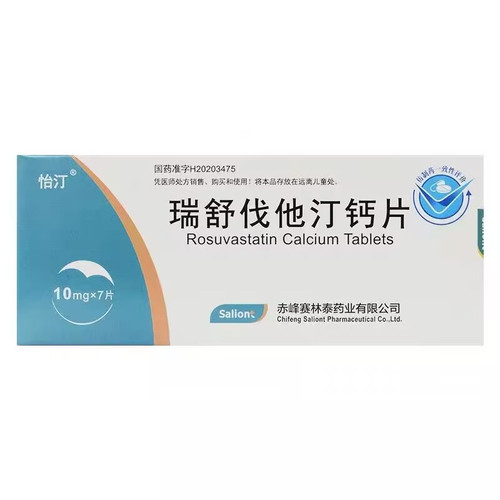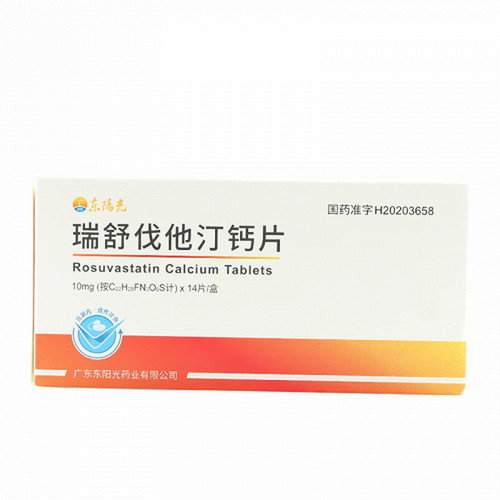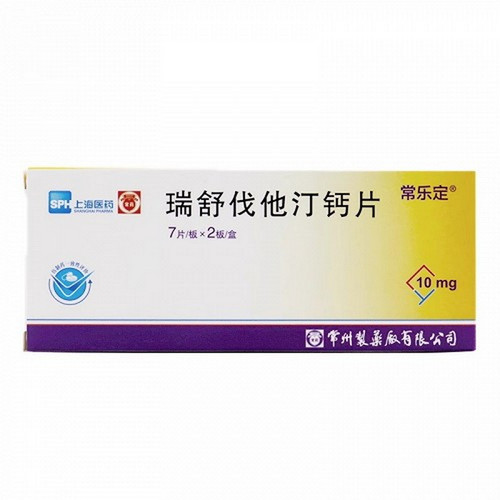Product Overview
[Drug Name]
Generic Name: Rosuvastatin Calcium Tablets
Trade Name: Shufutan
English Name: Rosuvastatin Calcium Tablets
Chinese Pinyin: Rosuvastatin Calcium Tablets
[Ingredients]
The main ingredient of this product is rosuvastatin calcium.
[Properties]
This product is a film-coated tablet that appears white or off-white after removal of the coating.
[Indications]
1. This product is indicated for patients with primary hypercholesterolemia (type IIa, including heterozygous familial hypercholesterolemia) or mixed dyslipidemia (type IIb), whose dyslipidemia is not adequately controlled with diet and other non-drug therapies (e.g., exercise therapy, weight loss).
2. This product is also indicated for patients with homozygous familial hypercholesterolemia as an adjunct to diet and other lipid-lowering measures (e.g., LDL-denier depletion therapy), or when these measures are inadequate.
[Dosage and Administration]
Before starting treatment, patients should be placed on a standard cholesterol-lowering diet and maintain this diet during treatment. The use of this drug should be individualized, taking into account the patient's individual cholesterol level, anticipated cardiovascular risk, and potential risk of adverse reactions. It is administered orally. The usual starting dose of this drug is 5 mg once daily. The selection of the starting dose should take into account the patient's individual cholesterol level, anticipated cardiovascular risk, and potential risk of adverse reactions. For patients requiring more intensive low-density lipoprotein cholesterol (LDL-C) lowering, a starting dose of 10 mg once daily can be considered; this dose controls lipid levels in most patients. If necessary, the dose can be adjusted to a higher dose level after four weeks of treatment. The maximum daily dose of this drug is 20 mg.
This drug can be taken at any time of day, with or without food.
1. Use in Patients with Renal Impairment
No dose adjustment is required for patients with mild and moderate renal impairment. All doses of this drug are contraindicated in patients with severe renal impairment. 2. Use in Patients with Hepatic Impairment
Systemic exposure of rosuvastatin was not increased in subjects with a Child-Pugh score of 7 or less.
Elevated systemic exposure was observed in subjects with Child-Pugh scores of 8 and 9. In these patients, renal function should be evaluated. There is no experience with the use of this product in patients with a Child-Pugh score exceeding 9. This product is contraindicated in patients with active liver disease.
3. Race
Increased systemic exposure has been observed in subjects of Asian descent. This factor should be considered when determining the dosage for patients of Asian descent.
[Adverse Reactions]
Adverse reactions observed with this product were generally mild and transient. In controlled clinical trials, adverse events resulted in less than 4% of patients withdrawing from the trials. 1. The frequency of adverse events is ranked as follows: Common (1/100, 1, 10); Uncommon (1/1,000, 1/100); Rare (1/10,000, 1/1,000); Very Rare (1/10,000). 1.1 Common: Endocrine disorders (diabetes); Nervous system disorders (headache, dizziness); Gastrointestinal disorders (constipation, nausea, abdominal pain); Skeletal muscle, joint, and bone disorders (myalgia); Systemic disorders (asthenia). 1.2 Rare: Immune system disorders (allergic reactions, including angioedema); Gastrointestinal disorders (pancreatitis); Skeletal muscle, joint, and bone disorders (myopathy (including myositis) and rhabdomyolysis). As with other HMG-CoA reductase inhibitors, the incidence of adverse reactions with this product tends to increase with increasing dose. Renal Effects: Proteinuria (as measured by dipstick) has been observed in patients receiving this drug, with the majority of the protein originating from the renal tubules. Less than 1% of patients experienced an increase in proteinuria from absent or trace to + or greater at certain times during treatment with 10 mg and 20 mg, compared with approximately 3% of patients receiving 40 mg. At the 20 mg dose, increases in proteinuria from absent or trace to mild + were observed. In most cases, proteinuria spontaneously decreased or resolved with continued treatment. A causal relationship between proteinuria and acute or progressive renal disease cannot be established based on clinical trials and postmarketing data to date. Hematuria has been observed in patients receiving this drug, but clinical trial data indicate a low incidence. 2.1 Effects on Skeletal Muscle: Skeletal muscle effects, such as myalgia, myopathy (including myositis), and rarely, rhabdomyolysis, have been reported in patients receiving all doses of this drug, particularly in doses greater than 20 mg. 2.2 Dose-related elevations in creatine kinase (CK) levels have been observed in patients taking this product; most cases have been mild, asymptomatic, and transient. If CK levels are elevated (5 × ULN), treatment should be discontinued (see Precautions). 2.3 Hepatic Effects: As with other HMG-CoA reductase inhibitors, dose-related elevations in transaminases have been observed in a small number of patients taking this product; most cases have been mild, asymptomatic, and transient. 3. Postmarketing Experience: In addition to the reactions described above, the following adverse events have been reported during postmarketing use of this product: 3.1 Rare: Hepatobiliary disorders (elevated hepatic transaminase). 3.2 Very rare: Neurological disorders (polyneuropathy, memory loss); Hepatobiliary disorders (jaundice, hepatitis); Musculoskeletal disorders (arthralgia); Urinary disorders (hematuria). 3.3 Unknown: Respiratory, Thoracic, and Mediastinal Disorders (cough, dyspnea); Gastrointestinal Disorders (diarrhea); Skin and Subcutaneous Tissue Disorders (Stevens-Johnson Syndrome); General Symptoms and Administration Site Conditions (edema); Psychiatric Disorders: Depression, Sleep Disorders (including insomnia and nightmares). 3.4 Pediatric Patient Population: In 52-week clinical trials, pediatric and adolescent patients treated with rosuvastatin experienced elevations of creatine kinase greater than 10 × ULN and muscle symptoms associated with exercise or increased physical activity at a higher frequency than those observed in adult clinical trials. Otherwise, the safety profile of rosuvastatin in pediatric and adolescent patients was similar to that in adults.
[Contraindications]
This product is contraindicated in: 1. Patients with hypersensitivity to rosuvastatin or any of its ingredients. 2. Patients with active liver disease, including unexplained persistent elevations of serum aminotransferases and any elevation of serum aminotransferases greater than 3 times the upper limit of normal (ULN). 3. Patients with severe renal impairment (creatinine clearance 30 ml/min). 4. Patients with myopathy. 5. Patients taking cyclosporine concomitantly. 6. Pregnant or lactating women, as well as women who may become pregnant and are not using adequate contraceptive measures.
[Precautions]
1. Renal Effects: Proteinuria (as measured by dipstick) has been observed in patients treated with high doses, especially 40 mg. The protein is primarily derived from the renal tubules and, in most cases, is transient or intermittent. Proteinuria is not considered a precursor to acute or progressive renal disease (see Adverse Reactions). 2. Skeletal Muscle Effects: Skeletal muscle effects have been reported in patients receiving all doses of ezetimibe, including myalgia, myopathy, and, rarely, rhabdomyolysis, particularly in patients receiving doses greater than 20 mg. Extremely rare cases of rhabdomyolysis have been reported with the concomitant use of ezetimibe and HMG-CoA reductase inhibitors. Drug interactions cannot be ruled out; caution should be exercised when these drugs are used together. 3. Creatine Kinase Testing: Creatine kinase (CK) should not be measured after strenuous exercise or in the presence of plausible causes of elevated CK, as this can confound interpretation of the results. If baseline CK values are significantly elevated (5 × ULN), retesting should be performed within 5-7 days. If repeat testing confirms a baseline CK value of 5 × ULN, treatment should not be initiated. 4. Before Treatment: As with other HMG-CoA reductase inhibitors, caution should be exercised in patients with predisposing factors for myopathy or rhabdomyolysis. These factors include: renal impairment, hypothyroidism, personal or family history of hereditary muscle disorders, a history of muscle toxicity with other HMG-CoA reductase inhibitors or fibrates, alcohol abuse, age 70 years, conditions that may result in elevated blood levels, and concomitant use of fibrates. For these patients, the potential benefits of treatment should be balanced against the potential risks, and clinical monitoring is recommended. If baseline CK values are significantly elevated (5 × ULN), treatment should not be initiated. 5. During Treatment: Patients should be instructed to immediately report unexplained muscle pain, weakness, or cramping, especially if accompanied by malaise and fever. CK levels should be measured in these patients. If CK values are significantly elevated (5x ULN) or muscle symptoms are severe and cause daylong malaise (even if CK < 5x ULN), treatment should be discontinued. If symptoms resolve and CK levels return to normal, consider restarting levofloxacin or switching to the lowest dose of another HMG-CoA reductase inhibitor and closely monitor the patient. Regular monitoring of CK levels is not necessary for asymptomatic patients. In clinical studies, there was no evidence of increased effects on skeletal muscle in the small number of patients receiving levofloxacin concomitantly with other therapies. However, an increased incidence of myositis and myopathy has been observed in patients receiving other HMG-CoA reductase inhibitors concomitantly with fibric acid derivatives (including gemfibrozil), cyclosporine, niacin, azole antifungals, protease inhibitors, or macrolide antibiotics. Concomitant use of gemfibrozil with some HMG-CoA reductase inhibitors may increase the risk of myopathy. Therefore, co-administration of this product with gemfibrozil is not recommended. The benefits of co-administering this product with fibrates or niacin to further improve lipid levels should be carefully weighed against the potential risks of such a combination. This product should not be used in any patient with an acute, severe illness suggestive of myopathy or a predisposition to renal failure secondary to rhabdomyolysis (e.g., sepsis, hypotension, major surgery, trauma, severe metabolic, endocrine, or electrolyte abnormalities, or uncontrolled epilepsy). 6. Effects on the Liver: As with other HMG-CoA reductase inhibitors, this product should be used with caution in patients who consume excessive alcohol and have a history of liver disease. Liver function tests are recommended before starting treatment and within three months after initiation. If serum transaminases are elevated more than three times the upper limit of normal, this product should be discontinued or the dose reduced. For hypercholesterolemia secondary to hypothyroidism or nephrotic syndrome, the underlying disease should be treated before initiating this product. 7. Race: Pharmacokinetic studies have shown that drug exposure is higher in Asian subjects than in Caucasians. 8. Protease Inhibitors: Concomitant use with protease inhibitors is not recommended. 9. Lactose Intolerance: Patients with rare hereditary conditions such as galactose intolerance, lactase deficiency, or glucose-galactose malabsorption should not take this product. 10. Diabetes: As with other HMG-CoA reductase inhibitors, increases in HbA1c and blood glucose concentrations have been observed in patients taking rosuvastatin. An increased frequency of diabetes has been reported in patients at high risk for diabetes after taking rosuvastatin. 11. Pediatric Patient Population: For pediatric patients aged 10-17 years who are at the stage of secondary sexual maturity according to Tenner staging, the duration of rosuvastatin treatment is limited to one year, based on assessment of sexual growth (height), weight, and BMI (body mass index). After 52 weeks of study treatment, there were no effects on growth, weight, BMI, or sexual maturation. Clinical trial experience in children and pediatric patients is limited, and the long-term (greater than one year) efficacy of rosuvastatin in adolescent patients is unknown. In 52-week clinical trials of rosuvastatin, pediatric and adolescent patients experienced elevations in creatine kinase greater than 10 times the ULN, as well as muscle symptoms observed with exercise or increased physical activity, at a higher frequency than in adult clinical trials (see Adverse Reactions). 12. Effects on Driving and Operating Machines: Studies have not been conducted to determine the effects of this drug on driving and operating machines. However, based on its pharmacodynamic properties, this drug is unlikely to affect these abilities. Consider the possibility of dizziness during treatment when driving or operating machines.
[Use in Special Populations]
Precautions for Pediatric Use:
The safety and efficacy of this drug in children have not been established. Pediatric experience is limited to a small number of children (aged 8 years) with homozygous familial hypercholesterolemia. Therefore, this drug is not currently recommended for pediatric use.
Precautions for Pregnancy and Lactation:
1. This drug is contraindicated in pregnant and lactating women. 2. Women of childbearing potential should use appropriate contraceptive measures. 3. Because cholesterol and other cholesterol biosynthesis products are important for fetal development, the risks associated with HMG-CoA reductase inhibition outweigh the benefits of treatment in pregnant women. Animal studies provide limited evidence of reproductive toxicity. If a patient becomes pregnant while taking this drug, treatment should be discontinued immediately. Rosuvastatin is secreted in human rat milk. There are no data on the secretion of rosuvastatin in human milk.
Precautions for Elderly Patients:
No dose adjustment is required.
[Drug Interactions]
1. Cyclosporine: When this product is coadministered with cyclosporine, the AUC of rosuvastatin is, on average, 7-fold higher than that observed in healthy volunteers (compared to the same dose of this product). Coadministration does not affect cyclosporine plasma concentrations. 2. Vitamin K Antagonists: As with other HMG-CoA reductase inhibitors, initiating or increasing the dose of this product in patients taking concomitant vitamin K antagonists (e.g., warfarin) may result in an increase in the International Normalized Rate (INR). Discontinuing or decreasing the dose of this product may result in a decrease in the INR. In such cases, appropriate INR monitoring is necessary. 3. Gemfibrozil and Other Lipid-Lowering Products: Concomitant use of this product with gemfibrozil may increase the Cmax and AUC of rosuvastatin by 2-fold. Based on data from dedicated interaction studies, no pharmacokinetic interaction is expected between this product and fenofibrate, but a pharmacodynamic interaction may occur. Concomitant use of gemfibrozil, fenofibrate, other fibrates, and lipid-lowering doses of niacin (1 g/day) with HMG-CoA reductase inhibitors increases the risk of myopathy, likely due to their ability to cause myopathy when taken alone. 4. Protease inhibitors: Although the mechanism of the drug interaction is unclear, concomitant administration of protease inhibitors may significantly increase rosuvastatin exposure. In a pharmacokinetic study, coadministration of 20 mg of this product with a combination of two protease inhibitors (400 mg lopinavir/100 mg ritonavir) in healthy volunteers demonstrated an approximately 2-fold and 5-fold increase in the steady-state AUC (0-24) and Cmax of rosuvastatin, respectively. Therefore, concomitant use of this product is not recommended in HIV patients receiving protease inhibitor therapy (see [Precautions]). 5. Antacids: Concomitant administration of this product with an antacid suspension containing aluminum magnesium hydroxide can reduce rosuvastatin plasma concentrations by approximately 50%. This effect can be mitigated if antacids are administered 2 hours after taking this product. The clinical significance of this drug interaction has not been studied. 6. Erythromycin: Coadministration of this product with erythromycin resulted in a 20% decrease in the AUC (0-t) and a 30% decrease in the Cmax of rosuvastatin. This interaction may be due to the increased gastrointestinal motility caused by erythromycin. 7. Oral Contraceptives, Hormone Replacement Therapy (HRT): Concomitant use of this product with oral contraceptives increased the AUCs of estradiol and norgestrel by 26% and 34%, respectively. These increased plasma concentrations should be considered when selecting oral contraceptive dosages. Pharmacokinetic data are not available in subjects taking this product and HRT concomitantly; therefore, the possibility of a similar interaction cannot be ruled out. However, in clinical trials, this combination was common and well tolerated by patients. 8. Other Medications: Based on data from dedicated drug interaction studies, no clinically relevant interactions are anticipated between this product and digoxin. 9. Cytochrome P450 Enzymes: Data from both in vitro and in vivo studies indicate that rosuvastatin is neither an inhibitor nor an inducer of cytochrome P450 isoenzymes. Furthermore, rosuvastatin is a weak substrate for these enzymes. No clinically relevant interactions were observed between rosuvastatin and fluconazole (an inhibitor of CYP 2C9 and CYP 3A4) or ketoconazole (an inhibitor of CYP 2A6 and CYP 3A4). Coadministration with itraconazole (a CYP 3A4 inhibitor) increased the AUC of rosuvastatin by 28%, an increase not considered clinically significant. Therefore, drug interactions due to cytochrome P450-mediated metabolism are not expected.
[Pharmacology]
1. Rosuvastatin is a selective, competitive HMG-CoA reductase inhibitor. HMG-CoA reductase is the rate-limiting enzyme in the conversion of 3-hydroxy-3-methylglutaryl-CoA to mevalonate, a cholesterol precursor. Animal and cell culture studies have shown that rosuvastatin is highly and selectively taken up by the liver, making the liver a target organ for cholesterol-lowering effects. In vivo and in vitro studies have shown that rosuvastatin increases the number of hepatic LDL receptors on the cell surface, thereby enhancing LDL uptake and catabolism, and inhibits hepatic VLDL synthesis, thereby reducing the total number of VLDL and LDL particles. Rosuvastatin can lower total cholesterol, LDL-C, ApoB, and non-HDL-C levels in patients with homozygous and heterozygous familial hypercholesterolemia, non-familial hypercholesterolemia, and mixed dyslipidemia. Rosuvastatin also lowers triglycerides and increases HDL-C levels. For patients with isolated hypertriglyceridemia, rosuvastatin can lower total cholesterol, LDL-C, VLDL-C, ApoB, non-HDL-C, and triglyceride levels, while increasing HDL-C levels. The effects of rosuvastatin on cardiovascular morbidity and mortality have not yet been determined.
Storage: Store tightly closed in a dry place.
Specifications: 10mg x 7 tablets
Packaging: Box
Expiration Date: 24 months
Approval Number: National Medicine Standard H20113246
Manufacturer: Simcere Pharmaceutical Co., Ltd.









